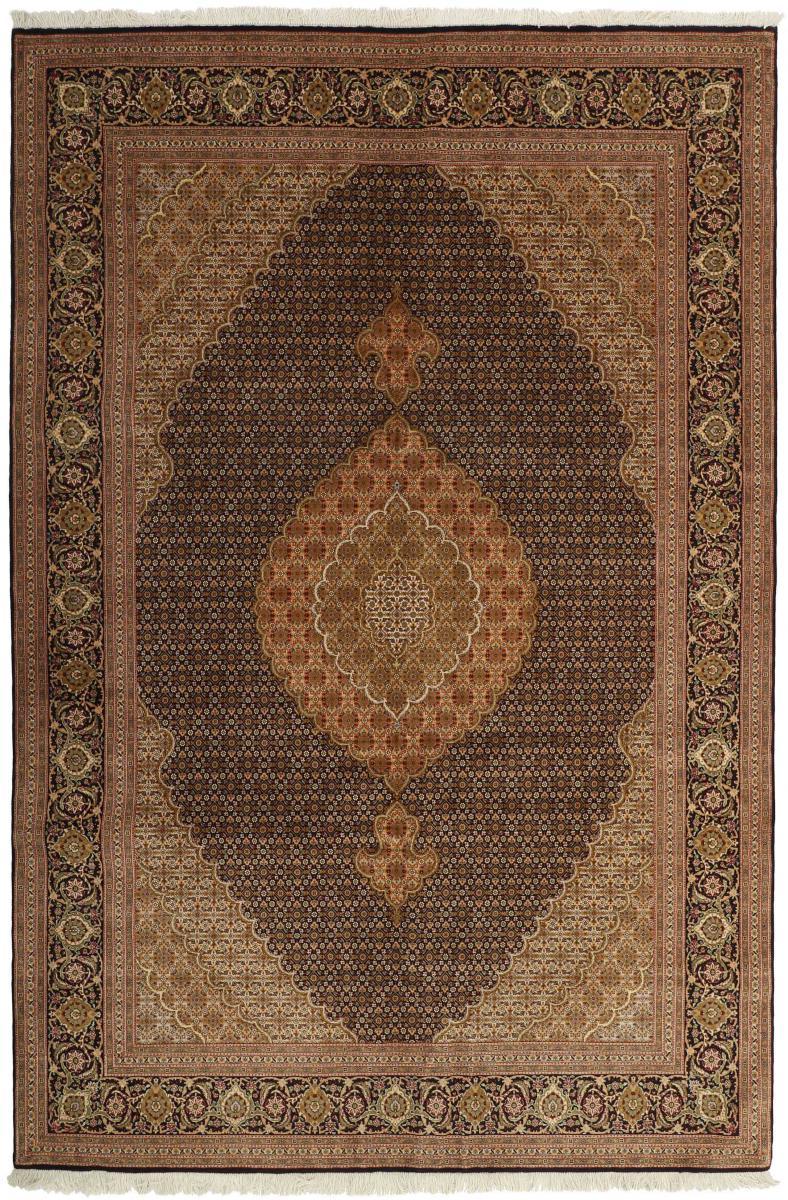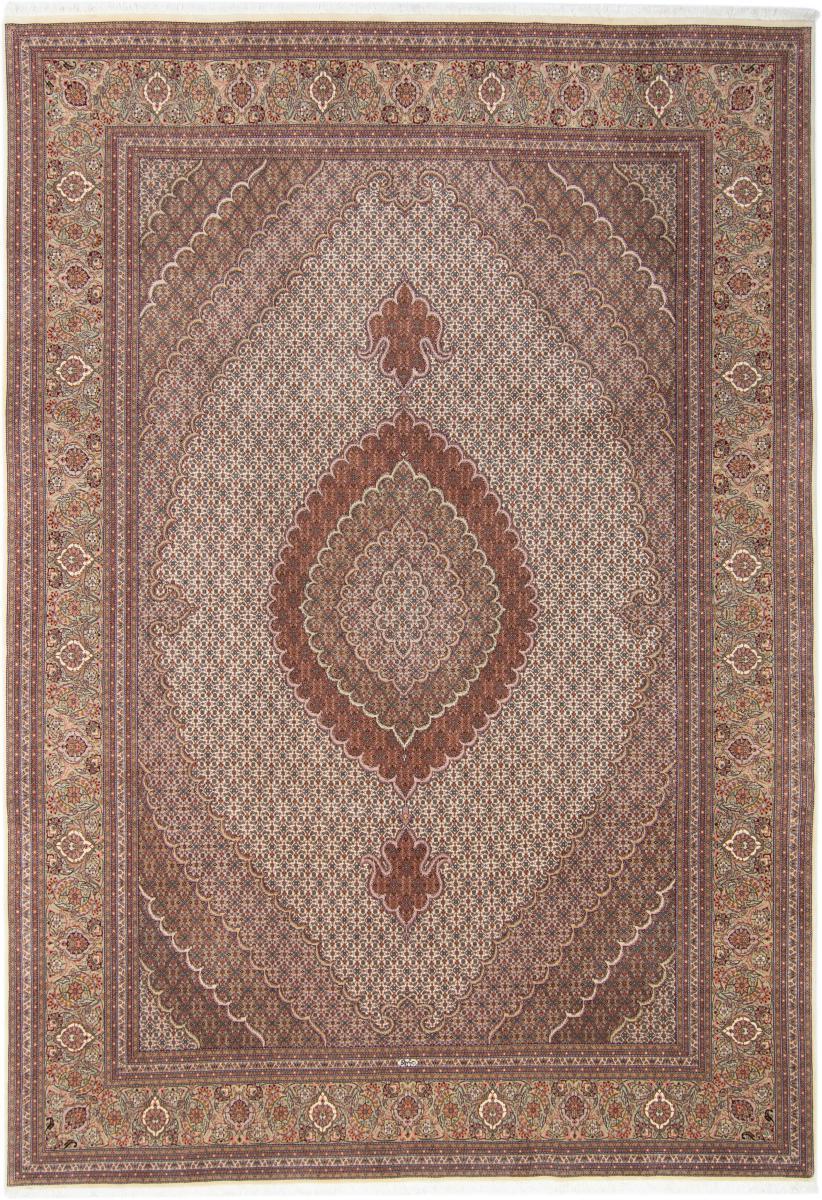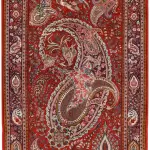Original pattern of Darham Mahi on Iranian carpets
The carpet is a work of art and the famous pattern of "Herati" known as "Darham Mahi" stands out on the background of many of these carpets and it is woven in most centers of carpet weaving in Iran including Azerbaijan, Kurdistan, Hamedan, Arak, Khorasan and... will be In this article, we are going to introduce the role of darham Mahi and also the most important areas of its tissue.
Introduction and history of the role of Mahi Darham
The Herati pattern is known as one of the most important motifs of Iranian carpets with the most common title and actually one of its types, "Darham Mahi". This is a graphic design consisting of two mutually bent leaves (in the form of analogy) that include a large flower such as a lotus or Shah Abbasi. These two leaves are actually the role of two Mahi, which later became two leaves. At the end of the Timurid period and the beginning of the Safavid period, this pattern became a common pattern in Iranian art, especially carpets, and since then it has become common in most areas of Iranian carpet weaving, and has spread to other countries such as India, Caucasus, Armenia, Turkey, Syria, Egypt, etc. has been transferred.
"Darham Mahi" has its roots in ancient Iranian culture
The enDarham Mahi design is one of the oldest and most common carpet designs in Iran. This design is often in the form of a vagirah and the weaver repeats the same vagirah in the length and width of the carpet. In this design, a rhombus-shaped pond with four leaves, Mahi can be seen around it. Mahi designs are known by different names in different parts of Iran. Its most important types are: Herati Mahi, Farahan Mahi, bee Mahi, Kurdistan Mahi and small Mahi. Darham Mahi is a beautiful, long-lasting and popular dish in the world markets, which has its roots in ancient Iranian culture. Because this design became popular in the Timurid period and in Herat, the artistic and political center of that period, and a large number of royal designs, both in carpets and in architecture, were formed with this design; It is also known as the Herati plan. The basis of Herati designs are two Mahies, which are surrounded by a large (usually eight-petaled) flower. Researchers are of the opinion that this role is related to ancient Iran and the seal ritual. In the seal religion, it is believed that the seal (Mithra) was born in water. For this reason, in the works of this ritual, Mehr is depicted as a child on a lotus and being taken out of the water by two dolphins (ibid). Also, in Avesta, two minnows are mentioned, which Ormuzd assigned to protect and guard the Gokar plant from the harm of the devil.
Varieties of Darham or Herati Mahi pattern
The overall design of the Darham Mahi comes from repeating the role of the main motif and joining them together. From the symmetrical repetition of four interlaced Mahi motifs, a rhombus pattern called "carousel" is formed in the middle, and usually above and below each carousel is a styled motif that is from the family of lotus motifs or fan palm motifs. Takes. The motif of the rhombus can be considered as a symbol of the pond, and the eight-petaled flower in the middle can also be considered as a symbol of the water lotus. The interlocking Mahi design is deliberately divided into two types: 1. Interlocking Mahi with rhombus 2. Interlocking Mahi without rhombus
In which regions of Iran is the motif of "Mahi Darham" woven?
The cities that are famous for weaving the motif of Mahi Mahi are Sarouk, Farahan, Arak, Sane (Sanandaj), Bijar, Hamedan, Zanjan, Tabriz, Khoi, Mashhad, Birjand, Derakhsh, Il Qashqai. Naqshmaye Mahi Darham is famous in Birjand as "Rizeh Mahi". The pattern of "Darham Mahi" is currently in most areas of carpet weaving in Iran with different names and titles such as Farahan Mahi, Birjand Mahi, Hamedan Mahi, Sene Mahi, small Mahi, small Mahi, chicken and Mahi, blade Mahi, bee Mahi, Mahi A comb and... are produced, in the general structure of all their designs, an eight-petaled flower is drawn in the middle and two bent leaves around it, and they are surrounded by a set of micro-patterns in the form of flowers, buds, bands and leaves. After traveling in different regions of Iran and due to being woven with different carpet weaving techniques (flat, half-loop and full-loop), this rug faced limited changes.

Characteristics of Darham Mahi carpet in different regions of Iran
As mentioned, the carpet texture with original Darham Mahi pattern is common in a number of regions of Iran. In the following, we mention some of the most important areas of the Darham Mahi carpet texture and the characteristics of each one.
The pattern of a Darham Mahi in a Tabriz carpet
The Darham Mahi motif in the Tabriz carpet is a type of Herati urban weaving and usually of a rhombus type. In the simple or multiple texts (with curved borders and dalbery) in the rugs of Vagira and Lakh and Taranj, they fill the entire surface and are summarized and do not have many details. The most famous types of Tabriz Mahi are small Mahi and marlan Mahi. Tabriz Mahi vagireh is square and includes components such as two leaf-shaped Mahies, flowers, and Mahi buds on the top and bottom of the rhombus, eight-petaled flower (between the Mahies, rhombuses, and corners of the vagireh) and small five-petaled flowers on the sides of the rhombuses. The placement of motifs in the vaghireh is diagonal, and therefore their state is rotating around the central flower (association of the state of circulation) and creates a circular form. Coloring is extremely important in Tabriz Mahi and differentiates the main backgrounds, bergamot and lach. Also, certain geometrical shapes appear from the placement of colors in the background. The main background of the carpet is blue and navy, and the background of bergamot and laces is in cream, runassy, and onion colors.
The motif of a Darham Mahi in Ardabil carpet
Currently, the Mahi motif is one of the most common and best-selling designs in Ardabil city, which is mostly custom-made and often woven in curtain sizes. Rural and nomadic Mahi Darham carpets are also woven in Ardabil in side, back and foot sizes, and in the Ardabil market it is known as the place of weaving or by the name of its original pattern. Its Mahi are almond-shaped), Qoltoq Mahi (the size of the Mahi is very large and large), Salman Abad Mahi, Bijar Mahi (with small Mahi) and Sane Mahi (small Mahi in the lakh and concentric tangs).
The pattern of a Darham Mahi in the mirage carpet (Mashayakhi)
Mashaikhi Mahi originally belongs to Sarab, which is also woven in other regions such as East Azerbaijan and Central Province. Mashaikhi Nelfiqi Mahi is of rural and urban style, and it seems that the half-loop weave method is effective in creating it. Color balance and compliance in design is one of the features of Mashaikhi Mahi. This role is usually implemented in the lach and tanger design of several texts (concentric) where the background color of the texts is different. Mashaikhi Mahi is similar to Tabriz Mahi, with the difference that its size is larger, its design is more broken, and the lines separating the texts are smooth and angular. In the mirage Mahi carpets, the background color is usually blue, navy blue, lacquered, and milky, and green, red, milky, and blue colors are used for motifs.
The pattern of Darham Mahi in the Birjand carpet
A type of Darham or Herati Mahi motif is woven in Birjand, Maud, and Derakhsh village under the name "Rizeh Mahi" (Mahi Maud), which is one of the main and dominant designs of this region. This role is implemented in the form of a national plan, Lakh and Taranj (small sunMahi) and Taranji (three texts, five texts and seven texts). Mahi Dharam Mod carpet is woven in both urban and rural style and is of Herati rhombus type. The type of placement of the Mahi in relation to the central flower in Vagira is diagonal or diagonal close to vertical, and its shape is rotating and has created a circular shape. Vaghireh in the formats of tranji (with solar tranj) and vaghireh covers the whole text and its size is small and square. Among the technical characteristics of Birjand Mahi Darham carpets, we can mention the fine texture, the use of cotton and woolen weft, tufting in the form of multiple folds of one weft and the use of asymmetric (Persian) knot. In this role, the samovar border is used. These carpets are woven in different sizes and shapes, including square, but rugs and side rugs are relatively less common among them. Large dimensions are woven for domestic demand and small dimensions for foreign demand. Blue, cream and lacquer colors are the dominant colors in Birjand's small Mahi carpet.
Salarkhani Baloch Mahi carpet
The most famous character of Herati in the Baloch areas is Mahi Salarkhani (belonging to a clan of the same name). In terms of its importance, this role is among the secondary designs and is considered uncommon compared to other motifs such as tree. This pattern, like other Baluch motifs, is in the nomadic style and of the Herati rhombic type, whose rhombus follows the type of local motifs of the region (having ram's head or toothed appendages). The type of placement of the Mahi in relation to the central flower is diagonal in some cases and horizontal in some cases; As if the Mahi are placed on and under the flower or they are placed next to the flower to cover it. Therefore, the association of rotation mode is very weak in this type. Mahi create an oval shape around the flower and in some cases a circle shape. The role of Mahi Salarkhani is performed in a big way and usually in the form of tranji. The colors used in this role, according to the Baloch style, are mainly dark colors with a lacquered background, brown and black. Baloch haratis are usually woven in small dimensions (an inch and a quarter/an inch and a half) and the borders used in it include local motifs such as ram's head chains and in some cases Dostkami border and Herati border in parallel and adjacent.
Mahi pattern on Qashqai carpets
One of the most important characteristics of Herati Qashqai carpets, which is present in some examples, is the different color of the rhombuses in the same carpet. Dostkami, Herati, and Shukri can be mentioned among the common borders in these carpets. In addition, the use of side edges known as semi-flower Mahi (bowl-plate) is also common next to the main edge. The use of happy and bright colors such as red, gold, green and enamel blue is one of the most important characteristics of Qashqai darham Mahi carpets.
The pattern of a Darham Mahi on the carpets of Kurdistan (Sanandaj)
Sanandaj Mahi is one of the most famous types of Mahi that is woven in two ways, small and large. A large Mahi is called a dog Mahi and a small Mahi is called a bee Mahi. The size of the Mahi sign has gradually become smaller and has become an age indicator sign. The Darham Mahi motif is usually performed in nomadic and rural styles in a rhombus type. Mahi Saneh is very brief and abstract, and the position of the motif of the Mahi is diagonal and in some cases close to horizontal. The shape of the Mahi is relatively rotating relative to the central flower and creates an almost oval shape. The number of rhombuses formed in the text is very high due to the small pattern. The role of Mahi Dareh in Sanandaj usually covers the entire text and in some cases only parts of the text in the forms of Lakh and Taranj, Se Taranj, Taranji, and Vagira. The fringes in these carpets are usually hexagonal or irregularly octagonal and have cow-headed fringes, and this is one of the characteristics of the Sane carpet fringes. The blue color in Sanandaj carpets is very transparent and the yellow color is like gold. Other dominant colors of this carpet are red and brown.
The pattern of Darham Mahi on the Sarooq carpet
The Mahi pattern is one of the main and important motifs of Sarouk carpets, which are woven in a rural style. Sarooq Mahi pattern is rhombus type, very fine and delicate, dense and compact, which evokes exquisite and fine fabrics. The placement of the motif of the Mahi around the flower is diagonal, rotating and curved. The motif of the Mahi is small, narrow and short with a rhombus-shaped head in a bent position and engraved with broken lines. The pattern of water lotus in Mahi Sarouk carpets is used in the geometric and abstract manner of the Sassanid period. Sarooq's Darham Mahi design in the form of lach and bergamot design covers the whole text and the separation of text parts is created with different colors. Navy blue, lacquer, blue, red, buttermilk and cream colors are used for the background and yellow, green and bright red colors are used for motifs.
Final word
Rizmahi pattern or darham Mahi is one of the original and common motifs in Iranian carpets, which is woven in some carpet-making regions of Iran, such as Kurdistan, Saroq, Ardabil, Birjand, etc. The basis of this pattern are Mahies or leaves that revolve around a central flower; However, the texture and texture of the pattern as well as its coloring are unique in each of the mentioned areas. By buying a carpet with the pattern of "Darham Mahi" you can own one of the most original and beautiful Iranian carpets.
You can inquire about Buying Handwoven Carpets , Buying Handwoven Kilim and Mats , and Buying Handwoven Pictorial Rug Tableaus online from the Hoveida Carpet Store and register all your orders and Wherever you are in the world, deliver it to the desired address in less than 4 working days.
If you are interested in reading other articles in the field of Handwoven carpets or Handwoven Pictorial Rug Tableaus , please refer to Hoveida Carpet Commercial .
Leave a comment
Your email address will not be published. Required fields are marked *












